[English] 日本語
 Yorodumi
Yorodumi- PDB-4hrn: Structural Basis for Eliciting a Cytotoxic Effect in HER2-Overexp... -
+ Open data
Open data
- Basic information
Basic information
| Entry | Database: PDB / ID: 4hrn | ||||||
|---|---|---|---|---|---|---|---|
| Title | Structural Basis for Eliciting a Cytotoxic Effect in HER2-Overexpressing Cancer Cells via Binding to the Extracellular Domain of HER2 | ||||||
 Components Components |
| ||||||
 Keywords Keywords | TRANSFERASE/DE NOVO PROTEIN / TRANSFERASE-DE NOVO PROTEIN complex | ||||||
| Function / homology |  Function and homology information Function and homology informationnegative regulation of immature T cell proliferation in thymus / ERBB3:ERBB2 complex / ERBB2-ERBB4 signaling pathway / GRB7 events in ERBB2 signaling / immature T cell proliferation in thymus / RNA polymerase I core binding / semaphorin receptor complex / regulation of microtubule-based process / ErbB-3 class receptor binding / Sema4D induced cell migration and growth-cone collapse ...negative regulation of immature T cell proliferation in thymus / ERBB3:ERBB2 complex / ERBB2-ERBB4 signaling pathway / GRB7 events in ERBB2 signaling / immature T cell proliferation in thymus / RNA polymerase I core binding / semaphorin receptor complex / regulation of microtubule-based process / ErbB-3 class receptor binding / Sema4D induced cell migration and growth-cone collapse / motor neuron axon guidance / neurotransmitter receptor localization to postsynaptic specialization membrane / PLCG1 events in ERBB2 signaling / ERBB2-EGFR signaling pathway / positive regulation of Rho protein signal transduction / ERBB2 Activates PTK6 Signaling / neuromuscular junction development / Drug-mediated inhibition of ERBB2 signaling / Resistance of ERBB2 KD mutants to trastuzumab / Resistance of ERBB2 KD mutants to sapitinib / Resistance of ERBB2 KD mutants to tesevatinib / Resistance of ERBB2 KD mutants to neratinib / Resistance of ERBB2 KD mutants to osimertinib / Resistance of ERBB2 KD mutants to afatinib / Resistance of ERBB2 KD mutants to AEE788 / Resistance of ERBB2 KD mutants to lapatinib /  Drug resistance in ERBB2 TMD/JMD mutants / Drug resistance in ERBB2 TMD/JMD mutants /  enzyme-linked receptor protein signaling pathway / ERBB2-ERBB3 signaling pathway / positive regulation of transcription by RNA polymerase I / oligodendrocyte differentiation / ERBB2 Regulates Cell Motility / semaphorin-plexin signaling pathway / PI3K events in ERBB2 signaling / positive regulation of protein targeting to membrane / positive regulation of cell adhesion / enzyme-linked receptor protein signaling pathway / ERBB2-ERBB3 signaling pathway / positive regulation of transcription by RNA polymerase I / oligodendrocyte differentiation / ERBB2 Regulates Cell Motility / semaphorin-plexin signaling pathway / PI3K events in ERBB2 signaling / positive regulation of protein targeting to membrane / positive regulation of cell adhesion /  regulation of angiogenesis / regulation of angiogenesis /  coreceptor activity / Schwann cell development / Signaling by ERBB2 / cellular response to epidermal growth factor stimulus / coreceptor activity / Schwann cell development / Signaling by ERBB2 / cellular response to epidermal growth factor stimulus /  myelination / TFAP2 (AP-2) family regulates transcription of growth factors and their receptors / GRB2 events in ERBB2 signaling / Downregulation of ERBB2:ERBB3 signaling / myelination / TFAP2 (AP-2) family regulates transcription of growth factors and their receptors / GRB2 events in ERBB2 signaling / Downregulation of ERBB2:ERBB3 signaling /  transmembrane receptor protein tyrosine kinase activity / transmembrane receptor protein tyrosine kinase activity /  neurogenesis / SHC1 events in ERBB2 signaling / Constitutive Signaling by Overexpressed ERBB2 / regulation of ERK1 and ERK2 cascade / basal plasma membrane / positive regulation of translation / phosphatidylinositol 3-kinase/protein kinase B signal transduction / positive regulation of epithelial cell proliferation / Signaling by ERBB2 TMD/JMD mutants / positive regulation of MAP kinase activity / neurogenesis / SHC1 events in ERBB2 signaling / Constitutive Signaling by Overexpressed ERBB2 / regulation of ERK1 and ERK2 cascade / basal plasma membrane / positive regulation of translation / phosphatidylinositol 3-kinase/protein kinase B signal transduction / positive regulation of epithelial cell proliferation / Signaling by ERBB2 TMD/JMD mutants / positive regulation of MAP kinase activity /  neuromuscular junction / neuromuscular junction /  wound healing / Signaling by ERBB2 ECD mutants / Signaling by ERBB2 KD Mutants / wound healing / Signaling by ERBB2 ECD mutants / Signaling by ERBB2 KD Mutants /  receptor protein-tyrosine kinase / neuron differentiation / receptor protein-tyrosine kinase / neuron differentiation /  receptor tyrosine kinase binding / cellular response to growth factor stimulus / Downregulation of ERBB2 signaling / ruffle membrane / peptidyl-tyrosine phosphorylation / receptor tyrosine kinase binding / cellular response to growth factor stimulus / Downregulation of ERBB2 signaling / ruffle membrane / peptidyl-tyrosine phosphorylation /  cell surface receptor protein tyrosine kinase signaling pathway / Constitutive Signaling by Aberrant PI3K in Cancer / transmembrane signaling receptor activity / PIP3 activates AKT signaling / cell surface receptor protein tyrosine kinase signaling pathway / Constitutive Signaling by Aberrant PI3K in Cancer / transmembrane signaling receptor activity / PIP3 activates AKT signaling /  myelin sheath / myelin sheath /  presynaptic membrane / presynaptic membrane /  heart development / PI5P, PP2A and IER3 Regulate PI3K/AKT Signaling / RAF/MAP kinase cascade / positive regulation of cell growth / basolateral plasma membrane / heart development / PI5P, PP2A and IER3 Regulate PI3K/AKT Signaling / RAF/MAP kinase cascade / positive regulation of cell growth / basolateral plasma membrane /  protein tyrosine kinase activity / positive regulation of MAPK cascade / cell surface receptor signaling pathway / protein tyrosine kinase activity / positive regulation of MAPK cascade / cell surface receptor signaling pathway /  receptor complex / receptor complex /  early endosome / endosome membrane / intracellular signal transduction / positive regulation of protein phosphorylation / apical plasma membrane / protein heterodimerization activity / early endosome / endosome membrane / intracellular signal transduction / positive regulation of protein phosphorylation / apical plasma membrane / protein heterodimerization activity /  protein phosphorylation / protein phosphorylation /  signaling receptor binding / positive regulation of cell population proliferation / negative regulation of apoptotic process / perinuclear region of cytoplasm / signaling receptor binding / positive regulation of cell population proliferation / negative regulation of apoptotic process / perinuclear region of cytoplasm /  signal transduction / signal transduction /  nucleoplasm / nucleoplasm /  ATP binding / ATP binding /  membrane / identical protein binding / membrane / identical protein binding /  nucleus / nucleus /  plasma membrane plasma membraneSimilarity search - Function | ||||||
| Biological species | synthetic (others)  Homo sapiens (human) Homo sapiens (human) | ||||||
| Method |  X-RAY DIFFRACTION / X-RAY DIFFRACTION /  SYNCHROTRON / SYNCHROTRON /  MOLECULAR REPLACEMENT / MOLECULAR REPLACEMENT /  molecular replacement / Resolution: 2.65 Å molecular replacement / Resolution: 2.65 Å | ||||||
 Authors Authors | Jost, C. / Schilling, J. / Plueckthun, A. | ||||||
 Citation Citation |  Journal: Structure / Year: 2013 Journal: Structure / Year: 2013Title: Structural Basis for Eliciting a Cytotoxic Effect in HER2-Overexpressing Cancer Cells via Binding to the Extracellular Domain of HER2. Authors: Jost, C. / Schilling, J. / Tamaskovic, R. / Schwill, M. / Honegger, A. / Plueckthun, A. | ||||||
| History |
|
- Structure visualization
Structure visualization
| Structure viewer | Molecule:  Molmil Molmil Jmol/JSmol Jmol/JSmol |
|---|
- Downloads & links
Downloads & links
- Download
Download
| PDBx/mmCIF format |  4hrn.cif.gz 4hrn.cif.gz | 83.1 KB | Display |  PDBx/mmCIF format PDBx/mmCIF format |
|---|---|---|---|---|
| PDB format |  pdb4hrn.ent.gz pdb4hrn.ent.gz | 61.4 KB | Display |  PDB format PDB format |
| PDBx/mmJSON format |  4hrn.json.gz 4hrn.json.gz | Tree view |  PDBx/mmJSON format PDBx/mmJSON format | |
| Others |  Other downloads Other downloads |
-Validation report
| Arichive directory |  https://data.pdbj.org/pub/pdb/validation_reports/hr/4hrn https://data.pdbj.org/pub/pdb/validation_reports/hr/4hrn ftp://data.pdbj.org/pub/pdb/validation_reports/hr/4hrn ftp://data.pdbj.org/pub/pdb/validation_reports/hr/4hrn | HTTPS FTP |
|---|
-Related structure data
| Related structure data | 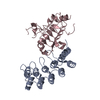 4hrlC 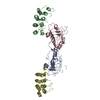 4hrmC 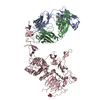 1n8zS  2jabS C: citing same article ( S: Starting model for refinement |
|---|---|
| Similar structure data |
- Links
Links
- Assembly
Assembly
| Deposited unit | 
| ||||||||
|---|---|---|---|---|---|---|---|---|---|
| 1 |
| ||||||||
| 2 | 
| ||||||||
| 3 | 
| ||||||||
| Unit cell |
|
- Components
Components
| #1: Protein | Mass: 14618.437 Da / Num. of mol.: 2 Source method: isolated from a genetically manipulated source Source: (gene. exp.) synthetic (others) / Plasmid: pQE30 / Production host:   Escherichia coli (E. coli) / Strain (production host): XL1-blue Escherichia coli (E. coli) / Strain (production host): XL1-blue#2: Protein | Mass: 11658.186 Da / Num. of mol.: 2 / Fragment: Domain IV, UNP RESIDUES 529-625 / Mutation: N8D, N49D Source method: isolated from a genetically manipulated source Source: (gene. exp.)   Homo sapiens (human) / Gene: ERBB2, HER2, MLN19, NEU, NGL / Plasmid: pFL / Cell line (production host): Sf9 / Production host: Homo sapiens (human) / Gene: ERBB2, HER2, MLN19, NEU, NGL / Plasmid: pFL / Cell line (production host): Sf9 / Production host:   Spodoptera frugiperda (fall armyworm) Spodoptera frugiperda (fall armyworm)References: UniProt: P04626,  receptor protein-tyrosine kinase receptor protein-tyrosine kinase |
|---|
-Experimental details
-Experiment
| Experiment | Method:  X-RAY DIFFRACTION / Number of used crystals: 1 X-RAY DIFFRACTION / Number of used crystals: 1 |
|---|
- Sample preparation
Sample preparation
| Crystal | Density Matthews: 3.9 Å3/Da / Density % sol: 68.45 % |
|---|---|
Crystal grow | Temperature: 293 K / Method: vapor diffusion / pH: 4 Details: 0.05M succinic acid, 29% ammonium sulfate, pH 4.0, vapor diffusion, temperature 293K |
-Data collection
| Diffraction | Mean temperature: 90 K | ||||||||||||||||||||||||||||||||||||||||||||||||||||||||||||||||||||||||||||||||||||||||||||||||||||||||||||||||||||||||||||||||||||||||||||||||||||||||||||||||||||||||||||||||||||||||||||||||||||||||||||||||||
|---|---|---|---|---|---|---|---|---|---|---|---|---|---|---|---|---|---|---|---|---|---|---|---|---|---|---|---|---|---|---|---|---|---|---|---|---|---|---|---|---|---|---|---|---|---|---|---|---|---|---|---|---|---|---|---|---|---|---|---|---|---|---|---|---|---|---|---|---|---|---|---|---|---|---|---|---|---|---|---|---|---|---|---|---|---|---|---|---|---|---|---|---|---|---|---|---|---|---|---|---|---|---|---|---|---|---|---|---|---|---|---|---|---|---|---|---|---|---|---|---|---|---|---|---|---|---|---|---|---|---|---|---|---|---|---|---|---|---|---|---|---|---|---|---|---|---|---|---|---|---|---|---|---|---|---|---|---|---|---|---|---|---|---|---|---|---|---|---|---|---|---|---|---|---|---|---|---|---|---|---|---|---|---|---|---|---|---|---|---|---|---|---|---|---|---|---|---|---|---|---|---|---|---|---|---|---|---|---|---|---|---|
| Diffraction source | Source:  SYNCHROTRON / Site: SYNCHROTRON / Site:  SLS SLS  / Beamline: X06SA / Wavelength: 1 Å / Beamline: X06SA / Wavelength: 1 Å | ||||||||||||||||||||||||||||||||||||||||||||||||||||||||||||||||||||||||||||||||||||||||||||||||||||||||||||||||||||||||||||||||||||||||||||||||||||||||||||||||||||||||||||||||||||||||||||||||||||||||||||||||||
| Detector | Type: PSI PILATUS 6M / Detector: PIXEL / Date: Aug 22, 2012 | ||||||||||||||||||||||||||||||||||||||||||||||||||||||||||||||||||||||||||||||||||||||||||||||||||||||||||||||||||||||||||||||||||||||||||||||||||||||||||||||||||||||||||||||||||||||||||||||||||||||||||||||||||
| Radiation | Protocol: SINGLE WAVELENGTH / Monochromatic (M) / Laue (L): M / Scattering type: x-ray | ||||||||||||||||||||||||||||||||||||||||||||||||||||||||||||||||||||||||||||||||||||||||||||||||||||||||||||||||||||||||||||||||||||||||||||||||||||||||||||||||||||||||||||||||||||||||||||||||||||||||||||||||||
| Radiation wavelength | Wavelength : 1 Å / Relative weight: 1 : 1 Å / Relative weight: 1 | ||||||||||||||||||||||||||||||||||||||||||||||||||||||||||||||||||||||||||||||||||||||||||||||||||||||||||||||||||||||||||||||||||||||||||||||||||||||||||||||||||||||||||||||||||||||||||||||||||||||||||||||||||
| Reflection | Highest resolution: 2.65 Å / Num. obs: 23767 / % possible obs: 99.9 % / Observed criterion σ(I): -3 / Biso Wilson estimate: 64.811 Å2 / Rmerge(I) obs: 0.041 / Net I/σ(I): 26.42 | ||||||||||||||||||||||||||||||||||||||||||||||||||||||||||||||||||||||||||||||||||||||||||||||||||||||||||||||||||||||||||||||||||||||||||||||||||||||||||||||||||||||||||||||||||||||||||||||||||||||||||||||||||
| Reflection shell | Diffraction-ID: 1
|
-Phasing
Phasing | Method:  molecular replacement molecular replacement | |||||||||
|---|---|---|---|---|---|---|---|---|---|---|
| Phasing MR | Model details: Phaser MODE: MR_AUTO
|
- Processing
Processing
| Software |
| ||||||||||||||||||||||||
|---|---|---|---|---|---|---|---|---|---|---|---|---|---|---|---|---|---|---|---|---|---|---|---|---|---|
| Refinement | Method to determine structure : :  MOLECULAR REPLACEMENT MOLECULAR REPLACEMENTStarting model: 1N8Z, 2JAB Resolution: 2.65→48.75 Å / Occupancy max: 1 / Occupancy min: 1 / SU ML: 0.31 / σ(F): 1.99 / Phase error: 30.67 / Stereochemistry target values: ML
| ||||||||||||||||||||||||
| Solvent computation | Shrinkage radii: 0.9 Å / VDW probe radii: 1.11 Å / Solvent model: FLAT BULK SOLVENT MODEL | ||||||||||||||||||||||||
| Displacement parameters | Biso max: 86.21 Å2 / Biso mean: 47.5965 Å2 / Biso min: 27.12 Å2 | ||||||||||||||||||||||||
| Refinement step | Cycle: LAST / Resolution: 2.65→48.75 Å
|
 Movie
Movie Controller
Controller


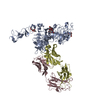
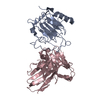


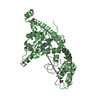
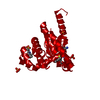




 PDBj
PDBj









